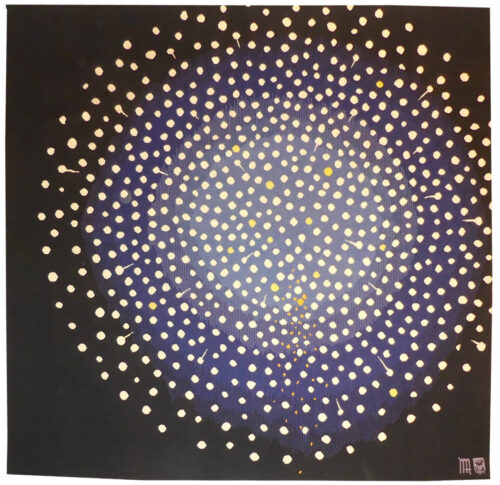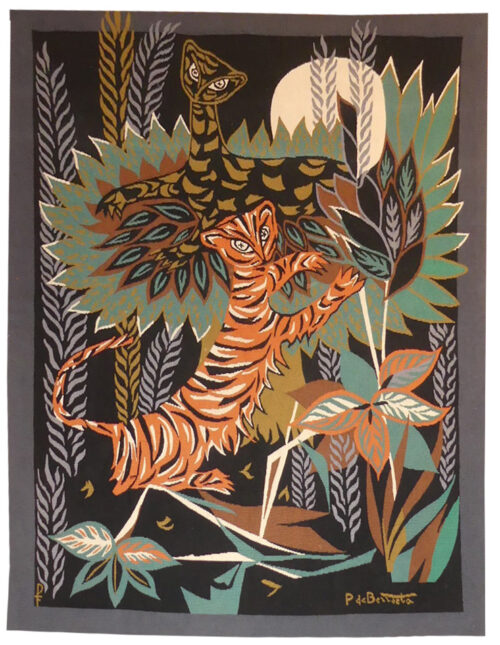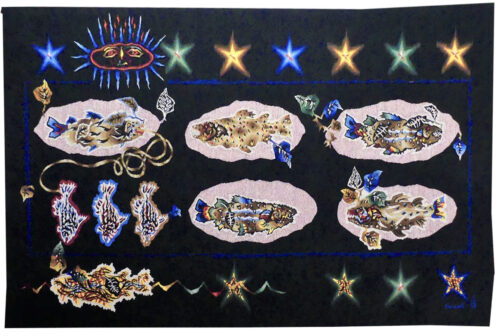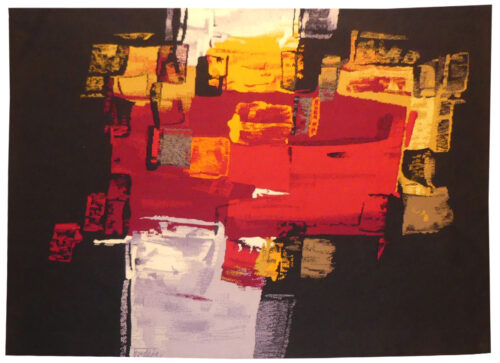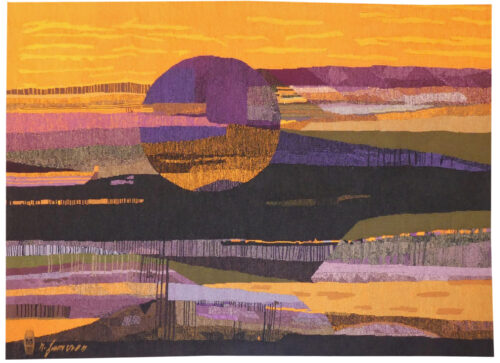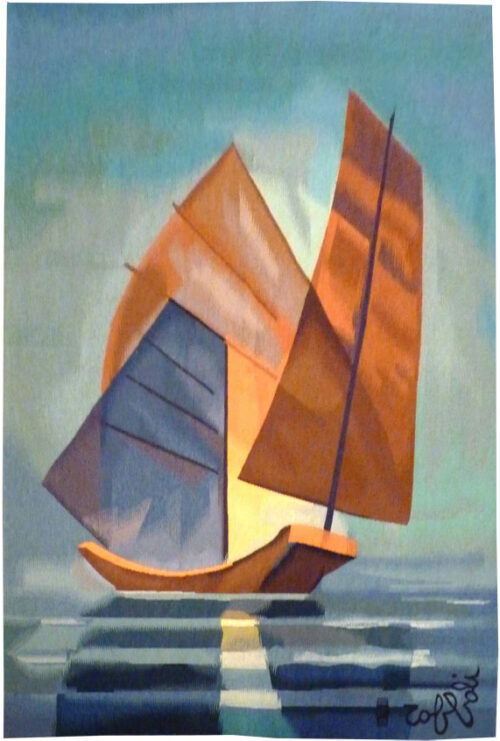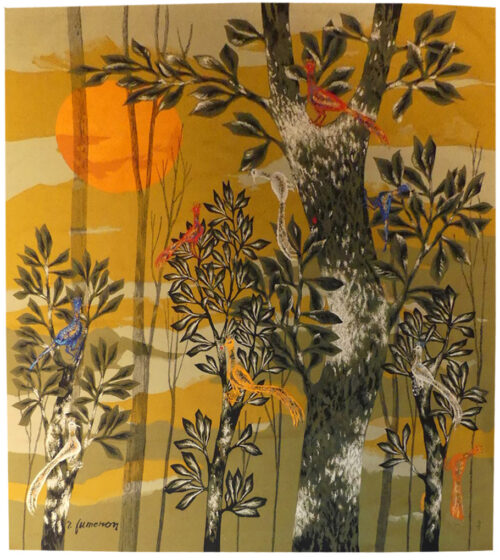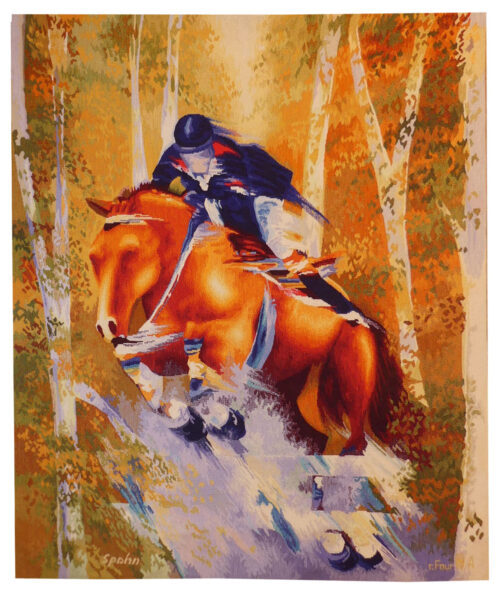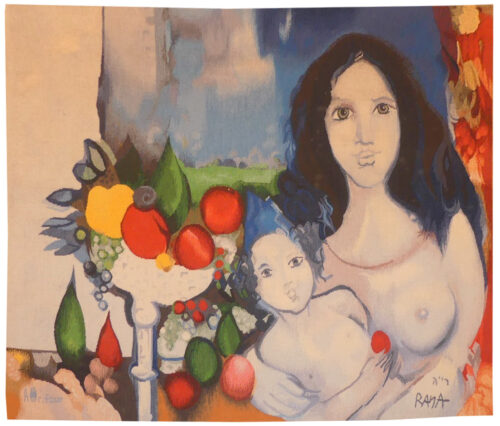-
Mark Adams made his first tapestry cartoons in 1952 (a multi-talented artist he also painted murals and designed stain-glass windows…). He arrived in France in 1955, working with Lurçat at Tours Saint-Laurent and also at the Ecole Nationale d’Art Décoratif in Aubusson. One of the very few American peintres-cartonniers, he participated in the Biennales de Lausanne, and produced over a hundred cartoons most of which were woven in Aubusson, notably by Paul Avignon. Recognised above all for his tapestry designs featuring wing motifs, Mark Adams sought inspiration in many and varied fields. Our "tapestry is related to the "Fire fountain" tapestry, and is another design that focuses on the display pattern from the light and sparks of a fireworks display against the dark sky (Multi-authored, Mark Adams, catalogue raisonné of tapestries, Stanford University Press, 2012, n°033, p.91). Bibliography : Multi-authored, Mark Adams, catalogue raisonné of tapestries, Stanford University Press, 2012Aubusson tapestry woven by the Avignon workshop. 1960.
-
Kenya
On returning to France in the 1950’s after a lengthy period spent in Argentina, Berroeta produced quite a number of cartoons in a style which was first figurative (animals, human figures,...) then turned to abstraction, as in his paintings. Exotic inspiration is a recurrent theme in Berroeta's work, often in an allusive way: neither the animals nor the plants are definitively identifiable, together, they have an allegorical purpose.Aubusson tapestry woven by the Pinton workshop. With signed label. Circa 1960. -
Brochette (skewer)
Lurçat’s artistic production was immense : it is however his role as the renovator of the art of tapestry design which ensures his lasting renown. As early as 1917, he started producing works on canvas, then in the 20’s and 30’s, he worked with Marie Cuttoli. His first collaboration with the Gobelins workshop dates back to 1937, at the same time he discovered the tapestry of the Apocalypse which was essential in his decision to devote himself to tapestry design. He first tackled the technical aspects with François Tabard, then on his installation at Aubusson during the war, he established his technique : broad point, a simplified palette, outlined cartoons with colours indicated by pre-ordained numbers. A huge production then follows (over 1000 cartoons) amplified by his desire to include his painter friends, the creation of the A.P.C.T. (Association des Peintres-Cartonniers de Tapisserie) and the collaboration with the art gallery La Demeure and Denise Majorel, and then by his role as a tireless advocate for the medium around the world. His tapestries reveal a pictorial world which is specifically decorative, with a very personal symbolic iconography : cosmogony (the sun, the planets, the zodiac, the four elements…) stylised vegetation, fauna (rams, cocks, butterflies, chimera …) standing out against a background without perspective (voluntarily different from painting) and, in his more ambitious work, designed as an invitation to share in a poetic (he sometimes weaves quotations into his tapestries) and philosophical (the grand themes are broached from the wartime period onwards) vision whose climax is the “Chant du Monde” (Song of the World) (Jean Lurçat Museum , ancien hôpital Saint Jean, Angers) which remained unfinished at his death. The skewers are discreet (in some cartoons, Lurçat does not hesitate to place fish on tridents), and the fish appear as if on a stall, an arrangement that echoes the partitioning of his famous wardrobes. Bibliography : Tapisseries de Jean Lurçat 1939-1957, Pierre Vorms Editeur, 1957 Exhibition Catalogue Lurçat, 10 ans après, Musée d'Art moderne de la ville de Paris, 1976 Exhibition catalogue Les domaines de Jean Lurçat, Angers, Musée Jean Lurçat et de la tapisserie contemporaine, 1986 Symposium Jean Lurçat et la renaissance de la tapisserie in Aubusson, Aubusson, Musée départemental de la tapisserie 1992 Exhibition Catalogue Dialogues avec Lurçat, Musées de Basse-Normandie, 1992 Exhibition catalogue Jean Lurçat, Donation Simone Lurçat, Académie des Beaux-Arts, 2004 Jean Lurçat, le chant du monde Angers 2007 Gérard Denizeau, Jean Lurçat, Liénart, 2013 Exhibition Catalogue Jean Lurçat au seul bruit du soleil, Paris, galerie des Gobelins, 2016Aubusson tapestry woven in the Tabard workshop. With signed label. Circa 1955. -
D'or et d'ombre (of gold and shade)
Originally a sculptor exploiting very diverse materials (steel, concrete, clay…), Borderie came to tapestry with immense enthusiasm in the 1950’s with the weaving of his first cartoon in 1957. Receiving encouragement from Denise Majorel, he was awarded the Grand Prix National de la Tapisserie in 1962. In 1974 he was appointed as director at the Ecole Nationale des Arts Décoratifs at Aubusson but he resigned from this post shortly thereafter. He designed over 500 painted cartoons, abstracts using simple shapes, shading in a limited palette of colours and weaving with gros points. Here we find the same preoccupations with light (and shadow) as in ‘les armes de la lumière’ (and as in Matégot's work). Borderie was also woven by workshops other than Legoueix in Aubusson, Rado, Daquin and, more confidentially, Chartron in Angers (who wove Jorj Morin in particular). Bibliography : Exhibition catalogue André Borderie « pour l’homme simplement », Angers, Musée Jean Lurçat et de la Tapisserie Contemporaine, 1998 Exhibition Catalogue André Borderie et la tapisserie d’Aubusson, Aubusson, Manufacture Saint-Jean, 2018Tapestry woven in the Cartron workshop. With signed label, n°1/1. Circa 1970. -
Composition orange
Aubusson tapestry woven by le mur du nomade workshop. N°1/6. Circa 1970.Fumeron designed his first cartoons (he would ultimately make over 500) in the 1940’s, in collaboration with the Pinton workshop, he was then commissioned on numerous occasions by the state before participating in the decoration of the ocean liner “France”. His work was figurative to begin with and influenced by Lurçat, then turned towards abstraction, before coming back to a style characterised by colourful figurative and realistic depictions from the 1980’s onwards. The setting sun, the orange chromatic range and the composition on the edge between figuration and abstraction are characteristic of the artist's cartoons from this period. -
Le grand large (the wide, open sea)
Toffoli produced a large number of tapestries in collaboration with the Robert Four workshop from 1976 onwards, designing several hundred cartoons. In them we find post-cubist transparent effects which are characteristic of the artist, as indeed are the subjects treated. Thus Toffoli’s tapestries do not differ from his painting : travelling for inspiration, here he illustrates a junk observed during trips to the far East.Aubusson tapestry woven by the Four workshop. N°1/6. Circa 1980. -
Composition with birds
Aubusson tapestry woven by the Pinton workshop. With signed label. Circa 1960.Fumeron designed his first cartoons (he would ultimately make over 500) in the 1940’s, in collaboration with the Pinton workshop, he was then commissioned on numerous occasions by the state before participating in the decoration of the ocean liner “France”. His work was figurative to begin with and influenced by Lurçat, then turned towards abstraction, before coming back to a style characterised by colourful figurative and realistic depictions from the 1980’s onwards. Birds perched on a tree in front of an orange sun, against a khaki background: a typical cartoon in the artist's decorative and naturalist vein (see ‘Sienna sky’, for example); the only thing that sets our model apart is its size. -
Jumping
Aubusson tapestry woven by the Four workshop. With signed label, n°EA 1/2. Circa 2000. The Manufacture Four has called on a number of living artists (including Toffoli and Lartigaud) to weave them, adding a new dimension to Spahn’s pictorial production, the painter of movement and sport. -
Maternité (Motherhood)
Aubusson tapestry woven by the Four workshop. With signed label, n°5/6. Circa 2000. The Manufacture Four has called on a number of living artists (including Toffoli and Lartigaud) to weave them, adding a new dimension to Raya-Sorkine's pictorial production, with its strong lyrical expressiveness and vibrant colours. Bibliography : R. Guinot, la tapisserie d’Aubusson et de Felletin, Lucien Souny, 2009, ill. p.161



